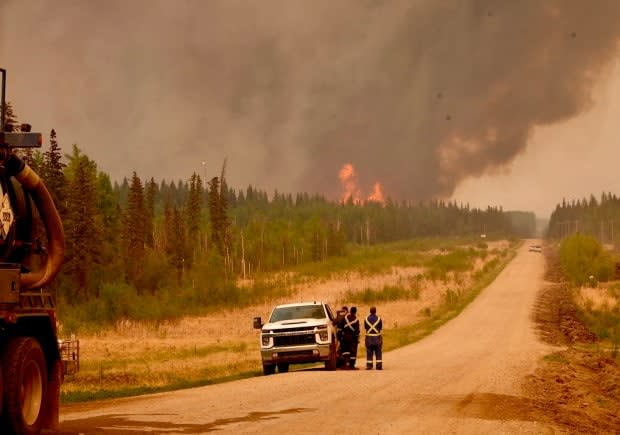If we're going to tackle worsening wildfires, we need to think differently, say those who know

Wildfires are raging again this spring across Western Canada, with flames ripping through forests in parts of Alberta, British Columbia, Saskatchewan and the Northwest Territories.
In Alberta alone, roughly 98 wildfires were burning and 26 were classified as out of control on Thursday, according to the latest update, and officials have already enlisted the help of nearly 1,000 out-of-province firefighters from across Canada and the U.S.
This shouldn't come as a surprise, said Mike Flannigan, a professor and wildfire expert at Thompson Rivers University in Kamloops, B.C.
"We're getting warmer, so we're seeing more fire," he said.
In the weeks after the spring thaw, forests are particularly vulnerable if it's been hot and dry — providing more "fuel" from the forest — while new vegetation hasn't yet had a chance to grow.
That's been the case this year, said Flannigan.
"It seems every three-to-five years we have a very active month of May in Alberta and this trend is continuing," he said, listing off the 2011 Slave Lake fire, the 2016 Fort McMurray fire and the Chuckegg Creek Wildfire of 2019.
As wildfires grow more powerful, Flannigan and other experts are calling on all levels of government to take a more proactive approach to get a handle on extreme fires.
WATCH | Why wildfire seasons are getting stronger and longer:
Feds set aside more money
Many of the most destructive wildfire events in Canadian history — based on area burned, suppression costs and the number of people forced to evacuate — have occurred in Western Canada during the last decade, research shows.
Those include the fire in Slave Lake, Alta., and Fort McMurray, which led to the largest evacuation in Canadian history, along with the 2021 fire that burned the 90 per cent of the community of Lytton, B.C.
Overall, the area burned annually by wildland fires has more than doubled since the 1970s, according to a disaster risk-assessment report released last week by the Canadian government.
It's predicted that, by the end of the century, the area burned could double again.

The federal report cites the federal government's $346 million commitment to train 1,000 fire fighters and support provinces and territories to acquire new firefighting equipment, as well as a plan to make a satellite system to monitor wildfires.
But the satellite system — still in the early stages of development — is only scheduled to be in place by 2029.
In its report, the government notes that "prevention and mitigation activities" will be "critical."
There will need to be increased focus, it says, on "the volume and composition of the forest fuels that drive wildland fires" as well as the "ability of the forest to recover from an increasing occurrence and severity of fire."
'More dangerous fire environment'
But experts say government's approach to forest management still hasn't caught up to the more extreme, devastating fires that threaten many parts of the country.
"We have a much more dangerous fire environment today," said Jen Baron, a PhD student at the University of British Columbia, who is focused on wildfires and forest ecology.
"The types of fires that we're seeing are exceeding our ability to suppress them in many cases, so hotter and drier fuels really large fires that start to build their own fire, weather and then a lot more fuel than we had in the past to drive them."
Given those changes, suppressing fires can be nearly impossible once the fires get going, she said.
"It's not just that we need more water bombers or more firefighters — we do need more resources — but that alone isn't going to address this increasing scale of the problem in part because these fires, when they get really large, we can't put crews on the ground."
Given that, Baron said there needs to be more preventative forest management plans to reduce the risk of high-intensity fires.
Baron said clearing away the dried grasses, brush and other organic material that make wildfires so powerful with prescribed burns will be increasingly crucial.
Ironically, the ability to put out fires quickly has left many forested areas vulnerable to more extreme fires because of the accumulation of dry organic matter that would have otherwise burned, she said.
"All of that fuel has been accumulating," she said, explaining that in parts of the interior of British Columbia "we have 10 fires worth of fuel accumulated that hasn't been removed from that system."
The benefits of fire
At times, added Flannigan, it may be necessary to let a fire burn and run its course — something certain jurisdictions are doing with increasing regularity, he said.
"That's to me very progressive and at times fires can be beneficial," he said.
"With recently burned areas, it becomes a patchwork quilt. Recently burned areas are unlikely to reburn, or if they do, it's lower intensity. So if it's unwanted fire, they can put it out fairly easily."
WATCH | Western Canada battles wildfires:
Other times, he said, stricter fire bans — or even a full-out bans on the presence of people in forests for a short period — would help during peak periods of risk in the spring, to ensure human-caused fires don't lead to disaster.
Kent Moore, a University of Toronto climate scientist and physics professor, said changes may even be needed to the way communities are zoned to make sure homes aren't built deep into the forest, or right up to the tree line.
"It's like most things. Our infrastructure is built for a climate we don't have anymore," said Moore.
"We probably have to change the way we live in the boreal forest."

 Yahoo Sports
Yahoo Sports 